Hudson Motor Car Company
The Hudson Motor Car Company made Hudson and other brand automobiles in Detroit, Michigan, U.S., from 1909 to 1954. In 1954, Hudson merged with Nash-Kelvinator to form American Motors Corporation (AMC). The Hudson name was continued through the 1957 model year, after which it was discontinued.
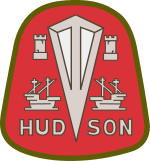 | |
| Industry | Automobile |
|---|---|
| Fate | Merged |
| Predecessor | Aerocar |
| Successor | American Motors Corporation (AMC) |
| Founded | May 25, 1909 |
| Defunct | July 4, 1954 |
| Headquarters | Detroit, Michigan, United States |
Key people | Joseph L. Hudson, Roy D. Chapin, A.E. Barit |
| Products | Vehicles |
Company strategy
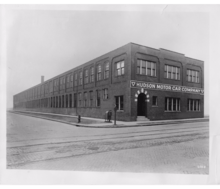



The name "Hudson" came from Joseph L. Hudson, a Detroit department store entrepreneur and founder of Hudson's department store, who provided the necessary capital and gave permission for the company to be named after him. A total of eight Detroit businessmen formed the company on February 20, 1909,[2] to produce an automobile which would sell for less than US$1,000 (equivalent to approximately $28,456 in 2019 funds[3]).
One of the chief "car men" and organizer of the company was Roy D. Chapin, Sr., a young executive who had worked with Ransom E. Olds. (Chapin's son, Roy Jr., would later be president of Hudson-Nash descendant American Motors Corp. in the 1960s). The company quickly started production, with the first car driven out of a small factory in Detroit on July 3, 1909 at Mack Avenue and Beaufait Street in Detroit, occupying the old Aerocar factory.[1]
The new Hudson "Twenty" was one of the first low-priced cars on the American market and very successful with more than 4,000 sold the first year. The 4,508 units made in 1910 was the best first year's production in the history of the automobile industry and put the newly formed company in 17th place industry-wide, "a remarkable achievement at a time" when there were hundreds of makes being marketed.[4]
Successful sales volume required a larger factory. A new facility was built on a 22-acre parcel at Jefferson Avenue and Conner Avenue in Detroit's Fairview section that was diagonally across from the Chalmers Automobile plant.[1] The land was the former farm of D.J. Campau. Until the late 1920s, bodies for Hudson cars were built by Biddle and Smart. On 1 July 1926, Hudson's new $10 million body plant was completed where the automaker could now build the all-steel closed bodies for both the Hudson and Essex models. It was designed by the firm of renowned industrial architect Albert Kahn with 223,500 square feet and opened on October 29, 1910.[5] Production in 1911 increased to 6,486.[6] For 1914 Hudsons for the American market were now left hand drive.
The company had a number of firsts for the auto industry; these included dual brakes, the use of dashboard oil-pressure and generator warning lights, and the first balanced crankshaft, which allowed the Hudson straight-six engine, dubbed the "Super Six" (1916), to work at a higher rotational speed while remaining smooth, developing more power for its size than lower-speed engines. The Super Six was the first engine built by Hudson, previously Hudson had developed engine designs and then had them manufactured by Continental Motors Company. Most Hudsons until 1957 had straight-6 engines. The dual brake system used a secondary mechanical emergency brake system, which activated the rear brakes when the pedal traveled beyond the normal reach of the primary system; a mechanical parking brake was also used. Hudson transmissions also used an oil bath and cork clutch mechanism that proved to be as durable as it was smooth.
At their peak in 1929, Hudson and Essex produced a combined 300,000 cars in one year, including contributions from Hudson's other factories in Belgium and England; a factory had been built in 1925 in Brentford in London.[7] Hudson was the third largest U.S. car maker that year, after Ford Motor Company and Chevrolet.[8]
Essex and Terraplane
.jpg)
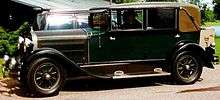
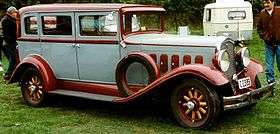

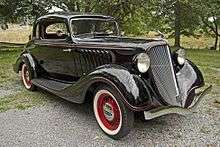
In 1919, Hudson introduced the Essex brand line of automobiles; the line was originally for budget-minded buyers, designed to compete with Ford and Chevrolet, as opposed to the more up-scale Hudson line. The Essex found great success by offering one of the first affordable sedans, and combined Hudson and Essex sales moved from seventh in the U.S. to third by 1925.[9]
In 1932, Hudson began phasing out its Essex nameplate for the modern Terraplane brand name. The new line was launched on July 21, 1932, with a promotional christening by Amelia Earhart. For 1932 and 1933, the restyled cars were named Essex-Terraplane; from 1934 as Terraplane, until 1938 when the Terraplane was renamed the Hudson 112. Hudson also began assembling cars in Canada, contracting Canada Top and Body to build the cars in their Tilbury, Ontario, plant. In England Terraplanes built at the Brentford factory were still being advertised in 1938.[10]
An optional accessory on some 1935–1938 Hudson and Terraplane models was a steering column-mounted electric gear pre-selector and electro-mechanical automatic shifting system, known as the "Electric Hand", manufactured by the Bendix Corporation. This took the place of the floor-mounted shift lever, but required conventional clutch actions. Cars equipped with Electric Hand also carried a conventional shift lever in clips under the dash, which could be pulled out and put to use in case the Electric Hand should ever fail. Hudson was also noted for offering an optional vacuum-powered automatic clutch, starting in the early 1930s.
Hudson Eight
For the 1930 model year Hudson debuted a new flathead inline eight cylinder engine with block and Crankcase cast as a unit and fitted with two cylinder heads. A 2.75-inch bore and 4.5-inch stroke displaced 218.8 cubic inches developing 80 horsepower (60 kilowatts; 81 metric horsepower) at 3,600 rpm with the standard 5.78:1 compression ratio. The 5 main bearing crankshaft had 8 integral counterweights, an industry first, and also employed a Lanchester vibration damper. Four rubber blocks were used at engine mount points. A valveless oil pump improved the Hudson splash lubrication system.
The new eights were the only engine offering in the Hudson line, supplanting the Super Six, which soldiered on in the Essex models.[5]
At the 1931 Indianapolis 500, Buddy Marr's #27 Hudson Special (using a Winfield carburetor) finished tenth.[11]
1936–1942
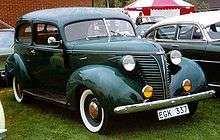
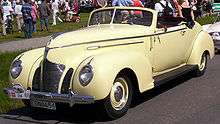


In 1936, Hudson revamped its cars, introducing a new "radial safety control" / "rhythmic ride" suspension which suspended the live front axle from two steel bars, as well as from leaf springs. Doing this allowed the use of longer, softer leaf springs ("rhythmic ride"), and prevented bumps and braking from moving the car off course. The 1936 Hudsons were also considerably larger inside than competitive cars — Hudson claimed a 145-cubic-foot (4.1 m3) interior, comparing it to the 121 cubic feet (3.4 m3) in the "largest of other popular cars" of the time. With an optional bulging trunk lid, Hudson claimed the trunk could accommodate 21 cubic feet (0.59 m3) of luggage. The 1936 engines were powerful for the time, from 93 to 124 horsepower (69 to 92 kilowatts; 94 to 126 metric horsepower).
The 1939 models joined other American cars in the use of a column-mounted gearshift lever. This freed front-seat passenger space and remained the industry standard through the 1960s, when "bucket seats" came into vogue. Hudson became the first car manufacturer to use foam rubber in its seats. The Hudson Terraplane was dropped. For 1940 Hudson introduced coil spring independent front suspension, aircraft-style shock absorbers mounted within the front springs and true center-point steering on all its models, a major advance in performance among cars in this price range. The Super Six model was reintroduced as well. Despite all these changes, Hudson sales for 1940 were lower than 1939 and the company lost money again. The advent of military contracts the following year brought relief.
The 1941 Hudsons retained the front end styling of the 1940 models but the bodies were new with 5.5 inches added to their length giving more legroom. A new manual 3-speed syncromesh transmission was quieter with all helical gears. Wheelbases increased by 3 inches, with offerings of 116, 121 and 128 inches, and height was decreased with flatter roofs. Convertibles now had a power operated top. Big Boy trucks now used the 128-inch wheelbase. In 1942, as a response to General Motors' Hydramatic automatic transmission, Hudson introduced its "Drive-Master" system. Drive-Master was a more sophisticated combination of the concepts used in the Electric Hand and the automatic clutch. At the touch of a button, Drive-Master offered the driver a choice of three modes of operation: ordinary, manual shifting and clutching; manual shifting with automatic clutching; and automatic shifting with automatic clutching. All this was accomplished by a large and complicated mechanism located under the hood. They worked well, and in fully automatic mode served as a good semi-automatic transmission. When coupled with an automatic overdrive, Drive-Master became known as Super-Matic. Re-engineering of the frame rear end to use lower springs reduced car height by 1.5 inches (38 mm). Sheet metal "spats" on the lower body now covered the running boards and new wider front and rear fenders accommodated this.
Female designer
As the role of women increased in car-purchase decisions, automakers began to hire female designers.[12] Hudson, wanting a female perspective on automotive design, hired Elizabeth Ann Thatcher in 1939, one of America's first female automotive designers.[13][14][15][16] Her contributions to the 1941 Hudson included exterior trim with side lighting, interior instrument panel, interiors and interior trim fabrics.[14] She designed for Hudson from 1939 into 1941, leaving the company when she married Joe Oros, then a designer for Cadillac. He later became head of the design team at Ford that created the Mustang.
World War II
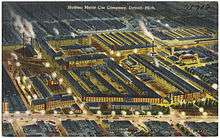
As ordered by the Federal government, Hudson ceased auto production from 1942 until 1945 in order to manufacture material during World War II, including aircraft parts and naval engines, and anti-aircraft guns. The Hudson "Invader" engine powered many of the landing craft used on the D-Day invasion of Normandy, June 6, 1944.
During World War II Hudson had also an aircraft division which produced ailerons for one large eastern airplane builder.[17][18] The plant was capable of large scale production of wings and ailerons as well as other airplane parts. On May 22, 1941, Hudson was given a contract for the Oerlikon 20 mm cannon with the Jefferson Avenue Plant, on Jefferson Avenue and Connor Avenue, responsible to convert the original Swiss drawings to American production standards.[19] The company produced 33,201 Oerlikons for the United States Navy with the original mechanism continued in use without major change and with complete interchangeability of parts until the end of the war.[19] Hudson also manufactured millions of other weaponry and vehicle parts for the war effort. Hudson ranked 83rd among United States corporations in the value of World War II military production contracts.[20]
1946–1954
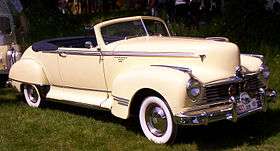


.jpg)
Production resumed after the war and included a 128-inch (3,251 mm) wheelbase three-quarter-ton pickup truck.[21]
In 1948, the company launched their "step-down" bodies, which lasted through the 1954 model year. The term step-down referred to Hudson's placement of the passenger compartment down inside the perimeter of the frame; riders stepped down into a floor that was surrounded by the perimeter of the car's frame. The result was not only a safer car, and greater passenger comfort as well, but, through a lower center of gravity, good-handling car. In time almost all U.S. automakers would embrace it as a means of building bodies. Automotive author Richard Langworth described the step-down models as the greatest autos of the era in articles for Consumer Guide and Collectible Automobile.
For the 1951 model year the 6 cylinder engine got a new block with thicker walls and other improvements to boost Horsepower by almost 18% and torque by 28.5% making Hudson a hot performer again. The GM-supplied 4-speed Hydramatic automatic transmission was now optional in Hornets and Commodore Custom 6s and 8s.
Hudson's strong, light-weight bodies, combined with its high-torque inline six-cylinder engine technology, made the company's 1951–54 Hornet an auto racing champion, dominating NASCAR in 1951, 1952, 1953, and 1954.
Herb Thomas won the 1951 and 1954 Southern 500s and Dick Rathmann won in 1952. Some NASCAR records set by Hudson in the 1950s (e.g. consecutive wins in one racing season) still stand even today. Hudson cars also did very well in races sanctioned by the AAA Contest Board from 1952 to 1954 with Marshall Teague winning the 1952 AAA Stock Car Championship and Frank Mundy in 1953. Often Hudsons finished in most of the top positions in races. Later, these cars met with some success in drag racing, where their high power-to-weight ratio worked to their advantage. Hudsons enjoyed success both in NHRA trials and local dirt track events.
As the post-war marketplace shifted from a seller's to a buyer's market the smaller U.S. automakers, such as Hudson and Nash, found it increasingly difficult to compete with the Big Three (Ford, GM and Chrysler) during the 1950s.[22] A sales war between Ford and General Motors conducted during 1953 and 1954 had left little business for the much smaller "independent" automakers trying to compete against the standard models offered by the domestic Big Three.[23] The Big Three could afford constant development and styling changes, so that their cars looked fresh every year, whereas the smaller manufacturers could only afford gradual change. Hudson's once innovative "step-down" unit body construction, while sturdy and innovative, also made restyling difficult and expensive. Although Hudsons dominated racing during this period, their feats did little to affect showroom traffic. Sales fell each year from 1951 to 1954 and only Korean War military contracts kept the company afloat. On March 20, 1954, the Hudson Motor Car Company reported a loss of $10,411,060 in 1953 as compared with a profit of $8,307,847 in 1952.[24]
After the company's high-priced Jet compact car line failed to capture buyers in its second straight year, Hudson CEO A.E. Barit engaged with George W. Mason, CEO of Nash-Kelvinator (makers of Nash and Rambler) to discuss the possibility of a merger with Nash. Mason already had the vision of merging the four independent auto makers (Nash, Hudson, Packard, and Studebaker) into one company to compete with the Big Three, having floated the idea as early as 1946 with Packard to no avail.[25] Mason had previously discussed the idea with Barit in 1952. On 14 January 1954 an agreement was reached and Nash and Hudson executives took the first steps to bring the two companies together.[26]
1954 – Merger with Nash-Kelvinator
On May 1, 1954, Hudson merged with Nash-Kelvinator to become American Motors Corporation. George W. Mason became CEO and president of AMC while Hudson's president, A.E. Barit retired to become an AMC board member.[27]
The Hudson factory, located in Detroit, Michigan, was converted to military contract production at the end of the model year, and the remaining three years of Hudson production took place at the Nash plant in Kenosha, Wisconsin. Nash would focus most of its marketing resources on its smaller Rambler models, and Hudson would focus its marketing efforts on its full-sized cars. The first Hudson model to terminate production was the Jet. The new company could then focus on the more successful Nash Rambler.[28] Henceforth, Hudson dealers would have badge-engineered versions of the Nash Rambler and Metropolitan compacts to sell as Hudson products.
One of the first things Mason did as CEO of the new company was to initiate talks with James J. Nance, president of Packard, for parts-sharing arrangements between AMC and Packard. At this time AMC did not have its own V8 engine and an agreement was made for the new 320 cu in (5.2 L) Packard V8 engine and Packard's Ultramatic automatic transmission to be used in the 1955 Nash Ambassador and Hudson Hornet models.
In July 1954, Packard acquired Studebaker to form Studebaker-Packard Corporation,[29] however further talks of a merger between AMC and Packard-Studebaker were cut short when Mason died on October 8, 1954. A week after his death, Mason's successor, George W. Romney, announced "there are no mergers under way either directly or indirectly".[30] Nevertheless, Romney continued with Mason's commitment to buy components from Studebaker-Packard Corporation. Although Mason and Nance had previously agreed that Studebaker-Packard would purchase parts from AMC, it did not do so. Moreover, Packard's engines and transmissions were comparatively expensive, so AMC began development of its own V8 engine, and replaced the outsourced unit by mid-1956.[31]
1955–1957

For 1955, both Hudson and Nash senior models were built on a common automobile platform using styling themes by Pinin Farina, Edmund E. Anderson, and Frank Spring. Common-body shell production for competing makes of automobiles was a manufacturing technique that had been used by the Big Three for decades. Anderson set up separate design studios for Nash, Hudson, and Rambler.
Although the 1955 Hudson used the inner body shell of the Nash, the car incorporated a front cowl originally designed by Spring and the Hudson team to be put on the 1954 Step-Down platform. The 1955 models also used the Hudson dashboard, "triple safe brakes" and the Nash Weather Eye heater with Harrison Radiator Corporation-supplied lower cost Freon/compressor type air conditioning.
For 1955, for the first time, Hudson offered a V8 engine, the Packard-designed and -built[32] 320-cubic-inch (5.2 L) engine rated at 208 hp (155 kW). All cars with the Packard V8 also used Packard's Ultramatic automatic transmission[33][34] as an option costing $494 (equivalent to approximately $4,646[3]);[32] the Nash 3-speed manual was also available at US$295.[35]
Hudson dealers also sold Rambler and Metropolitan models under the Hudson brand. (4357 Metropolitans were sold as "Hudson.") When sold by Hudson dealers, both cars were identified as Hudson vehicles via hood/grille emblems and horn buttons. Hudson Ramblers also received "H" symbols on fuel filler caps (and, in 1956, also on hubcaps).
In 1956 ex-Hudson president A.E Barit resigned from the Board in protest over the likelihood that Hudson would be phased out of production.
For 1956, design of the senior Hudsons was given over to designer Richard Arbib, which resulted in the "V-Line" styling motif, a combination of "V" motifs that carried Hudson's triangular corporate logo theme. Sales fell below 1955 figures.
With a wider front track than Nash used, Hudson was the better handling car, and was powered by the famed 308-cubic-inch (5.05 L) Hornet Six with the optional high-compression cylinder head and dual-carburetor manifold ("Twin-H Power"); the Twin H would disappear at the end of the 1956 model year.[36]
The Wasp used the 202-cubic-inch (3.3 L) L-head Jet Six engine (up to 130 hp [97 kW]) and this model (in sedan version) was Hudson's top seller. For 1957, Hudson dropped the shorter-wheelbase Wasp line, selling only the Hornet Custom and Super, which featured a lowered profile and slightly updated styling.
George W. Romney felt that Hudson and Nash were no longer relevant players in the automotive market and retired both names at the end of the 1957 model year production. Rambler and Metropolitan became makes in their own rights, and no longer were identified as Hudson or Nash.
End of the line
The last Hudson rolled off the Kenosha assembly line on June 25, 1957. There were no ceremonies, because at that point there was still hope of continuing the Hudson and Nash names into the 1958 model year on the Rambler chassis as deluxe, longer-wheelbase senior models. The combined Nash and Hudson production volume was not sufficient to justify all new design and tooling, so the Rambler's platform was expected to be adopted to the longer cars.[37] One major trade magazine said rumors of discontinuance were false and the 1958 Hudsons and Nashes "would be big and smart". Factory styling photographs show designs for a 1958 Hudson (and Nash) line based on a longer-wheelbase 1958 Rambler. Front-end prototype photos show separate Hudson and Nash styling themes.[38]
AMC's President, George W. Romney came to the conclusion that the only way to compete with the "Big Three" was to stake the future of AMC on a new smaller-sized car line.[39] Neither Hudson nor Nash brand names had as much positive market recognition as the successful Rambler and their sales were lagging. Together with AMC's chief engineer Meade Moore, Romney had completely phased out the Nash and Hudson brands at the end of 1957. The decision to retire the brands came so quickly that preproduction photographs of the eventual 1958 Rambler Ambassador show both Nash- and Hudson-badged versions. The Rambler brand was selected for further development and promotion while focusing exclusively on compact cars.[40]
Eventually, however, something close to the Hudson design was chosen for the 1958 Rambler Ambassador. Hudson brand enthusiasts will note the triangular grille guard and 1957-like fender "gun sights" and the fast-selling 1958 Rambler Customs wore 1957 Hudson-styled front-fender trim.
International markets
Hudson, Essex, and Terraplane vehicles were either exported as complete cars or locally-built from knock-down kits in many countries making the Hudson marque well known internationally as well as domestically. In its 1929 report, banking house Garden Detroit Company reported that in 1928 Hudson shipped 50,587 vehicles overseas, or 17.9% of total production.[41] By March 1929 Hudson had topped all previous production figures having exported 44,295 cars in March alone, bringing the total of shipments for the first quarter of 1929 to an all-time high of 108,298.[42]
Australia
.jpg)
.jpg)
.jpg)
Hudson vehicles were imported into Australia in 1913 by Brisbane company McGhie Motor Company.[43]
In 1915 the Sydney branch of Dalgety & Co. Ltd became the distributor of Hudson and Essex vehicles for New South Wales. The company was also the agent for Wolseley, Daimler, and Buick passenger vehicles as well as Lacre and Halley commercial vehicles.[44] Motor bodies were produced by Messrs Henderson, Boulton, and Kirkham in Regent Street, Sydney. The company also did trimming, fitting, painting, mechanical work, and repairs.[45]
Established in 1922, Sydney company Smith & Waddington set up motor vehicle body building operations for NSW and Queensland at premises on Parramatta Road, Camperdown. The company built "custom" car bodies which, by the terminology of the day, meant "built to an individual order and to a special design." In addition to Hudson and Essex for Dalgety, the company built vehicle bodies for Rolls-Royce, Wolseley, Dort, Benz, Fiat, and Tercat Mery.[46] After a slump which caused operations to cease in November 1927, Smith & Waddington resumed production in June 1928, again building for Hudson and Essex for NSW and Queensland, and further adding Dodge, Chrysler, Erskine, and Studebaker for the whole of Australia.[47][48] Additionally, Sydney coach builder G.H Olding & Sons are known to have built 6 Terraplane phaetons for Dalgety & Co. in 1934.
In 1926 a new company, Leader Motors Limited was formed to be the exclusive distributor of Hudson and Essex motor vehicles in Queensland. The bodies were made by South Australian company Holden's Motor Body Builders in Brisbane.[49] (In its home town of Adelaide, Holden's made motor bodies for Austin, Buick, Chevrolet, Cleveland, Dodge, Fiat, Oakland, Oldsmobile, Overland, Reo, Studebaker, and Willys Knight.)[50]
Hudson and Essex assembly began in Victoria by Neal's Motors of Port Melbourne in 1927. The contract to build the bodies was initially given to TJ Richards & Sons of Keswick, Adelaide to supply for Victoria, South Australia, Western Australia, and Tasmania as well as acting as a second source of supply for New South Wales and Queensland.[51][52][53] Holden's Motor Body Builders also built bodies. Holden's records show that for 1927 the Adelaide plant built a total 1641 Essex vehicles and 8 Hudsons, and for 1928 the plant built 1931 Essex vehicles and 59 Hudsons. 1928 would be Holden's final year for Hudson and Essex production, and in 1931 the company was bought out by General Motors.[54]
In February 1934 Ruskins Body Works of West Melbourne secured the contract to build Hudson and Terraplane bodies for the whole of Australia.[55] In June 1937 Neal's Motors celebrated assembling its 30,000th automobile: a 1937 Hudson Terraplane.[56]
In 1939 Dalgety & Co. sold their automotive business to Sydney company and agent for Packard motor vehicles,[57] Ira L. & A.C Berk Pty Ltd which thereafter became the distributors for Hudson in NSW and QLD.[58][59] The company opened a manufacturing plant in Belmore, Sydney in February, 1949.[60]
After the end of World War II, Australia legislated to restrict the use of U.S. dollars which were in desperately short supply. The use of U.S. dollars to import cars thereafter required a government permit restricting the purchase of American cars only to those with access to U.S. funds held overseas such as consular staff and visiting entertainers. Despite this, Australian distributors of Hudson, Nash, Packard and Studebaker were able to bring in limited numbers of US-built, factory right-hand-drive vehicles from 1946.[61]
Dunlop Rubber Company released a report in 1949 about Australian car sales for the period of 1932 to 1949 in which it reported that Hudson vehicles (including Essex and Terraplane) numbered 10,424 units for the 17-year period, coming in at 13th place overall. It was noted in the report generally that all marques in Australia experienced the greatest number of sales prior to World War II.[62]
In 1960, six years after the merger of Hudson and Nash-Kelvinator to form American Motors Corporation, Australian Motor Industries (AMI) of Port Melbourne would form an agreement with AMC to assemble Ramblers in Australia.[63]
Canada
Canadian assembly of Hudson vehicles commenced in 1932 by Hudson Motors of Canada in Tilbury, Ontario. The factory building was owned by Canadian Top & Body Co. which built the motor bodies for the vehicles. The first models assembled were a series of Hudson Eights. World War II interrupted operations and production ceased in 1941. Post-war operations resumed in 1950, with Hudsons being assembled by CHATCO Steel Products in Tilbury, Ontario.[64] Operations ceased in 1954 following the Nash-Hudson merger that lead to the formation of American Motors Corporation. Toronto-based Nash Motors of Canada Ltd. became American Motors (Canada) Ltd. and all subsequent AMC operations continued in Toronto.[65]
Germany
Hudson and Essex vehicles were assembled in Berlin, Germany during the 1920s by Hudson Essex Motors Company m.b.H Berlin-Spandau.[66] The cars were built with the speedometer in kilometers, while the fuel, oil, and temperature gauges remained in their original non-metric units.[67]
New Zealand
.jpg)
.jpg)
Hudson and Essex vehicles were imported into New Zealand by Dominion Motors of Wellington which began operations in 1912. After Dominion Motors amalgamated with Universal Motor Company of Christchurch in 1919[68] the company became the distributor for not only Hudson and Essex, but also Oldsmobile, Crossley, Chevrolet, Stutz, Rolls-Royce, and (pre-GM) Vauxhall. Vehicles were assembled and finished in-house from partial knock-down kits.
For South Island, Hudson and Essex vehicles were imported by W.G. Vining Limited of Nelson, beginning in 1912. Vining had built a 31,500 square feet (2,926.5 square meters) garage in 1908 which was the largest garage in New Zealand at the time. A car assembly plant was established at the premises and shortly thereafter Vinings obtained licenses to import and assemble Cadillac, Maxwell, Haynes, and Ford vehicles from the United States; Bean cars from the United Kingdom; and Darracq and Unic vehicles from France. Along with Hudson and Essex, the plant later assembled Chevrolet and Rover vehicles. The business ceased when it was sold on 30th September 1927 upon W.G. Vining's retirement.[69] Vining's son formed a new business, P. Vining & Scott, and continued the Hudson and Essex franchise, adding Morris in 1932.[70]
New Zealand car sales for the first nine months of 1927 saw Essex in third place with 898 vehicles sold, behind Chevrolet in second place with 1,100 vehicles sold, and Ford in first place with 1651 vehicles sold. Hudson made 12th place with 206 sales.[71]
From 1935, Hudson vehicles (along with Nash, Studebaker, and Standard) were assembled by Christchurch company Motor Assemblies Limited. Production ended when the company was acquired by Standard-Triumph International in 1954.[72]
From 1954 Hudson vehicles were built for the New Zealand market by Auckland company VW Motors as a secondary line to the Volkswagens they assembled. After the Hudson and Nash marques were dropped by AMC, VW Motors assembled AMC's new Rambler motor vehicles at its new Otahuhu Volkswagen plant from 1958 until 1962.[73][74] AMC formed an agreement in 1963 with Campbell Motor Industries (CMI) of Thames to assemble Ramblers, production of which ran from 1964 until 1971.
South Africa
Beginning in the 1920s, Hudson and Willys motor vehicles were assembled in South Africa from right-hand-drive complete knock-down (CKD) kits sourced from Canada by Stanley Motors at their plant, National Motor Assemblers (NMA), in Natalspruit (Gauteng).[16] After World War II, NMA, built Austin, Standard, and Triumph vehicles at different times. After the Hudson and Nash merger, NMA continued to assemble AMC Ramblers until 1967.[75]
United Kingdom
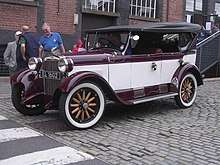

Hudsons were introduced to the United Kingdom in 1911. No shipments were possible during the First World War but as soon as the Armistice was signed exports resumed to the U.K. Hudsons and Essex vehicles were sold through ten concessionaires.
In 1922 Hudson-Essex Motors of Great Britain Limited was formed, with new premises on Dordrecht Road, in Acton Vale.[76] Over 100 agents were appointed to sell the vehicles resulting in 2,000 sales in the next 12 months.
In 1926 a factory was built on 4½ acres of ground on the recently opened Great West Road in Brentford.[77] The plant opened in 1927 and a year later a three-story building was built as a service department for Hudson and Essex vehicles. The factory assembled the vehicle chassis locally but the bodies were imported as complete units from Detroit.
From 1932, the bodies came over from the United States in sections to be assembled at the Great West Road factory. After the Essex marque was retired in 1932 the British company was renamed Hudson Motors Ltd.[78]
Hudson's new Terraplane model was equally as popular in the U.K as it was in the United States. English-designed and built bodies were built on the Terraplane frames and the cars were even entered in a number of races including the Monte Carlo Rally. Some of the cars entered were driven by personnel from the Great West Road factory. A Hudson Pacemaker won first place in the 1931 Scottish Rally, and another Pacemaker took 7th place in the 1932 Torquay Rally. The Team Award was won by two Terraplane tourers and a Terraplane saloon in the 1933 Scottish Rally.[79]
Because of the Hudson-Essex factory, the Chiswick roundabout (the junction of Chiswick High Road, North Circular Road, South Circular Road and the Great West Road) became known as "Hudson's Corner."
After the Hudson and Nash merger, the British company was renamed Rambler Motors (A.M.C.) Limited in 1966[80] and became an importer of American Motors Corporation vehicles well into the 1970s.
Legacy
For the 1970 model year, American Motors revived the "Hornet" model name for its new series of compact cars (the AMC Hornet). AMC was later purchased by Chrysler, which at one time considered reintroducing the Hornet name in the Dodge model line (See: Dodge Hornet).
The last Hudson dealership was Miller Motors in Ypsilanti, Michigan,[81] which is now part of the Ypsilanti Automotive Heritage Museum.
The Hostetler Hudson Auto Museum in Shipshewana, Indiana features a collection of restored Hudsons.[82] Eldon Hostetler was an inventor who owned a Hudson as a teenager and later purchased Hudson cars and restored them.[83]
A restored Hudson Dealership sign still occupies its original site on Highway 32 in Chico, California.[84]
The 2006 film, Disney/Pixar's Cars, features a character named Doc Hudson, represented as a 1951 Hudson Hornet.
The Hermes, a recurring car model featured in Rockstar Games' Grand Theft Auto video game series, is based on the 1951 Hudson Hornet.
Models
References
- "Still standing: the Aerocar/Hudson plant". Mac's Motor City Garage. 25 July 2013. Retrieved 27 November 2017.
- Burton, Clarence M., ed. (1922). The City of Detroit, Michigan, 1701-1922. S. J. Clarke Publishing. p. 583.
- Federal Reserve Bank of Minneapolis. "Consumer Price Index (estimate) 1800–". Retrieved January 1, 2020.
- "Hudson Motors". Cars & Parts. 42: 64. 1999. Retrieved 14 February 2015.
- Butler, Donald F. (1982). The History of Hudson. Motorbooks International. ISBN 9780879386962.
- Long, John C.; Hyde, Charles K. (2004). Roy D. Chapin: the man behind the Hudson Motor Car Company. Wayne State University Press. p. 98. ISBN 978-0-8143-3184-2. Retrieved 19 April 2013.
- "Ealing and Brentford: Economic history". A History of the County of Middlesex. Victoria County History. 7: 131–144. 1982. Retrieved 19 February 2016.
- Poremba, David Lee (2003). Detroit: A Motor City History. Arcadia Publishing SC. p. 116. ISBN 978-0-7385-2435-1. Retrieved 19 February 2016.
- Georgano, G.N. (2002). Cars: Early and Vintage, 1886-1930. Mason Crest Publishers. ISBN 978-1-59084-491-5.
- Greater London Council, The West London Report, London: Greater London Council, circa 1983.
- "(unknown)". Custom & Rod Ideas: 32. October 1977.
- Lamm, Michael; Holls, Dave (1996). A Century of Automotive Style: 100 Years of American Car Design (Second ed.). Lamm-Morada Publishing. p. 193. ISBN 9780932128072. Retrieved 19 February 2016.
- Studebaker hired Helen Dryden to design the 1936 President.
- "Obituary Elizabeth Anna (Betty) Oros" (in Romanian). biserica.org. 2001. Retrieved 19 February 2016.
- "A Moment With Joe & Betty Oros". Mustang Monthly. 24 June 2009. Archived from the original on 8 December 2012. Retrieved 19 February 2016.
archived at: archive (period) is/VMuM
- "Hudson Commodore Six: The History". South Africa: Franschhoek Motor Museum. Archived from the original on 20 February 2012. Retrieved 19 February 2016.
- Herman, Arthur (2012). Freedom's Forge: How American Business Produced Victory in World War II. Random House. pp. 114, 298, 310. ISBN 9781400069644.
- "Hudson ships ailerons". Milwaukee Sentinel. 15 May 1941. p. 5. Retrieved 19 February 2016.
- "20mm Antiaircraft Gun Chapter V". HyperWar Foundation. Retrieved 19 February 2016.
- Peck, Merton J.; Scherer, Frederic M. (1962). The Weapons Acquisition Process: An Economic Analysis. Harvard Business School. p. 619.
- Vance, Bill (22 May 2009). "Motoring Memories: Hudson Trucks, 1914–1957". Autos Canada. Retrieved 19 February 2016.
- Auto Editors of Consumer Guide (5 September 2007). "1956-1957 Rambler". auto.howstuffworks.com. Retrieved 19 February 2016.
- Flammang, James M. (1994). Chronicle of the American automobile: over 100 years of auto history. Publications International. p. 278. ISBN 978-0-7853-0778-5. Retrieved 19 February 2016.
- "$10,411,060 Loss Reported by Hudson". The Sun-Telegram. VII (50). San Bernardino, California. Associated Press. 21 March 1954. p. 1.
- "AMC Myths & AMC V8 Engines » Tampa Bay AMC".
- Severson, Aaron (January 25, 2009). "From Small Things: The Nash Metropolitan and the Birth of American Motors > Ate Up With Motor". Ate Up With Motor.
- https://www.hemmings.com/blog/2013/05/01/this-day-in-history-nash-kelvinator-and-hudson-merge/
- "Flameout: The Short, Sad Story of the Hudson Jet". Mac's Motor City Garage. 18 April 2018. Retrieved 18 August 2019.
- "Autos: Merger No. 3". Time. 28 June 1954. Retrieved 17 March 2013.
- "Personnel: Changes of the Week". Time. 25 October 1954. Retrieved 15 September 2013.
- "Autos: New Entry". Time. 24 March 1954. Retrieved 15 September 2013.
- Flory, p. 672.
- Kimes, Beverly Rae; Clark, Henry Austin, Jr., eds. (1985). The Standard Catalogue of American Cars 1805-1942 (Second ed.). Krause Publications. ISBN 978-0-87341-111-0.
- Dawes, Nathaniel D. (1975). The Packard: 1942-1962. A. S. Barnes. ISBN 978-0-498-01353-9.
- Flory, p.672.
- Flory, Jr., J. "Kelly" (2004). American Cars, 1960-1972: Every Model, Year by Year. McFarland. p. 700. ISBN 978-0-7864-1273-0.
- Railton, Art (April 1957). "Detroit Listening Post". Popular Mechanics. 107 (4): 99. Retrieved 19 February 2016.
- Hyde, Charles K. (15 November 2009). Storied Independent Automakers: Nash, Hudson, and American Motors. Wayne State University Press. p. 183. ISBN 9780814340868.
- "Gamble on the Rambler". Time. 19 December 1955. Retrieved 19 February 2016.
- Auto Editors of Consumer Guide (28 August 2007). "1950–1952 Rambler: The Low-Priced Rambler". auto.howstuffworks.com. Retrieved 19 February 2016.
- Hyde, Charles (2009). Storied Independent Automakers: Nash, Hudson, and American Motors. Wayne State University Press. p. 127. ISBN 978-0814334461.
- "HUDSON MOTOR CAR CO". May 23, 1929. p. 29 – via Trove.
- "THE HUDSON CAR". June 28, 1913. p. 3 – via Trove.
- "Catalogue - Dalgety & Co. Ltd, Motor Cars, 1912". Museums Victoria Collections.
- "MOTORS, BOTORS, AND AEROPLANES - HUDSON LIGHT SIX - The Sun (Sydney, NSW : 1910 - 1954) - 14 Aug 1915". Trove.
- Dunn, John C. (2006). Comeng 1: 1921 to 1955. ISBN 9781877058424.
- "SMITH AND WADDINGTON". June 13, 1928. p. 17 – via Trove.
- "Tony & Wendy' 1929 Roadster". hudson-amc.org.au.
- "NEW COMPANY". June 10, 1926. p. 16 – via Trove.
- "HOLDEN BODIES". May 9, 1926. p. 5 – via Trove.
- "T. J. Richards & Sons". August 25, 1927. p. 19 – via Trove.
- "LOCAL CAR ASSEMBLY - Hudson - Essex Plant Surprises - The Herald (Melbourne, Vic. : 1861 - 1954) - 24 Oct 1927". Trove.
- "HUDSON-TERRAPLANES - Local Bodies in Fortnight - The Herald (Melbourne, Vic. : 1861 - 1954) - 11 Jun 1934". Trove.
- "Holden Body Builders Production 1927 - 1930". www.uniquecarsandparts.com.au.
- "RUSKIN'S BIG CONTRACTS - Terraplane And Hudson Bodies - The Herald (Melbourne, Vic. : 1861 - 1954) - 5 Feb 1934". Trove.
- "MELBOURNE PLANT'S 30,000TH CAR. - The Horsham Times (Vic. : 1882 - 1954) - 25 Jun 1937". Trove.
- "IRA L. AND A. C. BERK - Evening News (Sydney, NSW : 1869 - 1931) - 13 Jan 1928". Trove.
- "1960 Rambler ad - Ira L & AC Berk". October 29, 2011 – via Flickr.
- "Hudson Motor Car Company Dealerships Other". www.hudsonjet.hetclub.org.
- "ROMANCE BEHIND RISE OF MANY FIRMS". April 11, 1949. p. 16 – via Trove.
- "HUDSON CAR MODELS". November 27, 1945. p. 6 – via Trove.
- "SERVICING OBSOLETE MOTORS - HUGE AUSTRALIAN JOB - Cairns Post (Qld. : 1909 - 1954) - 25 Mar 1949". Trove.
- https://www.australiaforeveryone.com.au/motoring-fifties.html
- "AMC - The Spirit Still Lives (history of American Motors)". www.allpar.com.
- "Hudson Motor Car Company Dealerships in Canada". www.hudsonjet.hetclub.org.
- "Alles einsteigen! Die Revolution des Verkehrswesens. Über 150 Jahre Eisenbahngeschichte; Technische Entwicklung; Einfluß auf die Wirtschaft; Politische Bedeutung by Deutsche Bundesbahn:: Zeitbild, Bonn, o.J. Mappe, 1. Ausgabe, 1. Band. - Antiquariat J. Hünteler". www.abebooks.com.
- "East German Resto of Essex". www.hudson-amc.org.au.
- A Powerful Company ’’Press’’, Volume LV, Issue 16515, 10 June 1919, Page 7
- "Vinings in the Motor industry". www.theprow.org.nz.
- http://nzetc.victoria.ac.nz/tm/scholarly/tei-NHSJ06_04-t1-body1-d7.html
- https://paperspast.natlib.govt.nz/newspapers/NZH19271112.2.218.52.3
- W D Rose, Development options in the New Zealand motor car assembly industry, Research paper 16, NZIER, 1971
- car., Volkswagen. NZ’s most popular European. "Volkswagen New Zealand - Discover". www.Volkswagen.co.nz. Retrieved 8 September 2017.
- Todd Niall, The Empty Halls of New Zealand's Car Assembly Industry. Sunday Star Times, 6 October 2018 accessed 28 February 2019
- "Motor Assemblies: MOTOR ASSEMBLIES LIMITED". January 24, 2012.
- "Hudson Essex Motors - Graces Guide". www.gracesguide.co.uk.
- "The Great West Road Then & Now | Brentford & Chiswick Local History Society". brentfordandchiswicklhs.org.uk. Retrieved 2019-08-05.
- "Fragments on forgotten makes | Motor Sport Magazine Archive". Motor Sport Magazine. 2014-07-07. Retrieved 2019-08-05.
- "60 years of the Terraplane | Motor Sport Magazine Archive". Motor Sport Magazine. 2014-07-07. Retrieved 2019-08-05.
- "Rambler Motors - Graces Guide". www.gracesguide.co.uk.
- Blumberg, George P. (11 April 2003). "Driving; Hudsons Survive. The Dealer Does, Too". The New York Times. Retrieved 19 February 2016.
- "Attractions in LaGrange County". backroads.org. Retrieved 19 February 2016.
- "A Driving Passion". Hostetler's Hudson Auto Museum. Archived from the original on 25 October 2016. Retrieved 19 February 2016.
- avidCommish10 (11 November 2011). "Old Hudson Dealership Sign, Walnut St, Chico, CA". Flickr. Retrieved 14 February 2015.
- The Hudson Triangle (1911-1919) Hudson Motor Car, Volumes 1-13.
External links
| Wikimedia Commons has media related to Hudson Motor Car Company. |
- Hudsonclub.org: "Hudson Car Club"
- Hetclub.org: Hudson-Essex-Terraplane Club
- Hudsonmotorcar.org: Canadian Hudson Motorcar website
- Lost Marques.com: Hudson
- Allpar.com: 1936 Hudson webpage with details
- Baulch, Vivian M. (December 2005). "How J.L. Hudson changed the way we shop" (PDF). The Hudson Hub. Retrieved 19 February 2016.
- Legends of NASCAR "Hudson Racing"
- Hudson, Hornet, Wasp, Pacemaker, Super 6, Super 8, 308, 262. 254, 232, Flathead 6 engine, Hollywood, Club Sedan, Twin H, Cater Carburetor, Smoky Yurnik, Bernie Siegfried, HET Club, Texas,
